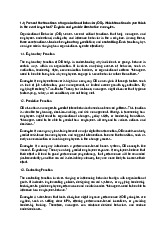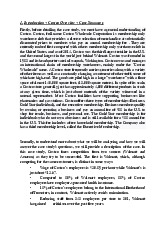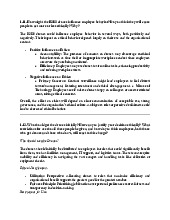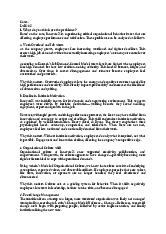






Preview text:
lOMoAR cPSD| 58591236 Đề 1 khóa 63
Part 1 (5 points) Multiple choice
1) Maurice Harper is a friendly and warm manager who starts her day at work by personally
greeting her colleagues and subordinates. Maurice is often seen listening sincerely to employees'
concerns and problems. She takes the initiative to hold programs to renew and improve the skills of
current employees. Most of her employees know that she is accessible for help and information at
all times Maurice is a(n) ________ leader.
A) achievement-oriented
B) transaction-oriented
C) employee-oriented -D) production-oriented E) task-oriented •
2) Which of the following theoretical approaches in the study of leadership focuses on followers'
readiness as a determinant of effective leadership?
A) Big Five personality model B) behavioral theories
C) Fiedler contingency model
D) laissez-faire leadership
E) situational leadership theory
3) Which of the following statements is true regarding the establishment of the organizational
culture and its effects on the organization?
A) Today's trend toward decentralized organizations makes it is easier to establish a strong culture.
B) In a virtual organization a strong culture can be established quickly and easily.
C) Employees organized in teams always show greater allegiance to the values of the organization as a
whole than to their team and its values.
D) Culture acts as a control mechanism and guides the behavior of employees.
E) Cultures reduce the stability of the social system in an organization.
4) Which of the following is typically a characteristic of the mechanistic model of organization? A) low formalization
B) rigid departmentalization @ decentralized management D) wide spans of control E) low specialization
5) Which of the following is most likely to be a characteristic of an organization pursuing an
innovation strategy? A) high formalization B) high specialization C) decentralized control
D) rigid departmentalization
E) narrow span of control
6) Jim is a salaried employee whose job is to develop content for online web sites. He discovers that
he is paid subtry thially, Whe in hit colleagues, even though their jobs for levels of piterance are lOMoAR cPSD| 58591236
very similar. According to the equity theory, what impact is this discovery most likely to have on his behavior and performance?
A) He will reduce the amount of work that he does on a daily basis.
B) He will compare his carings to those of another group of employees.
C) He will increase his productivity and/or the overall quality of his work.
D) He will seek a position within the company commensurate with his pay.
E) He will begin to look for a position outside of the company.
Jim is a salaried employee whose job is to develop content for online Web sites. He discovers that he
is paid substantially more than his colleagues even though their jobs and levels of performance are
very similar. According to the equity theory, what impact is this discovery most likely to have on his behavior and performance?
A) He will reduce the amount of work that he does on a daily basis.
B) He will compare his carings to those of another group of employees.
C) He will increase his productivity and/or the overall quality of his work.
D) He will seek a position within the company commensurate with his pay.
E) He will begin to look for a position outside of the company.
7) A plant manager organizes a plant by separating engineering, accounting, manufacturing,
personnel, and purchasing into departments. The plant is departmentalized on the basis òf ____ A) target customer B) product C) function D) geography E) service
8) The unbroken line of authority that extends from the top of the organization to the lowest
echelon and clarifies who reports to whom is termed ___ A) chain of command B) path of power C) span of control
D) line of responsibilityE) web of authority
9) Work specialization contributes to higher employee productivity — but at the price of _____
A) reduced economies of scale B) increased cost
C) reduced job satisfaction
D) restricted flow of information
E) increased complexity
10) Which of the following statements is true regarding an organization's culture?
A) Organizational culture is evaluative rather than descriptive.
B) Large organizations rarely have subcultures.
C) A dominant culture expresses the core values shared by a majority of the organization's members.
D) A strong culture reduces employee satisfaction and increases employee turnover. lOMoAR cPSD| 58591236
E) Subcultures and dominant cultures do not share any common values. Đề 1
Part 1 (5 points) Multiple choice
1. Which of the following statements is true regarding the job characteristics model?
A) The operation of the model is universal and unaffected by cultural factors.
B) The operation of the model is relatively individualistic in nature.
C) The operation of the model requires employees to have similar skill sets.
D) The operation of the model cannot be quantitatively measured.
2) According to the two-factor theory, ……….. A)
there exists a hierarchy of needs within every human being, and as each need is satisfied, the next one becomes dominant B)
Most employees inherently dislike work and must therefore be directed or even coerced into performing it C)
employees view work as being as natural as rest or play, and therefore learn to accept, and even seek, responsibility
D) the aspects that lead to job satisfaction are separate and distinct from those that lead to job dissatisfaction
3) Most people assume that police officers should behave in a lawful manner, refrain from
demonstrating favoritism to any particular group, and do their best to uphold the law. Which of the
following terms best represents these beliefs? A) diversity B) similarity C) role expectation
D) uncertainty reduction
4) When faced with a number of tight deadlines, Mandy Moore often delegates work collectively.
Recently she chose some fairly experienced employees to work on a high-priority project. She was
heartened to see that the selected group of employees was having numerous meetings and working
hard. However, when she went to check on their progress at the halfway mark in the project
schedule, she was shocked to see how little the team had done in the past three weeks. This scenario reflects ………… A) groupthink
B) collective efficacy C) social loafing D) groupshift
5)........................ leaders inspire followers to transcend their self-interests for the good of the
organization and can have an extraordinary effect on their followers. A) Transformational ) Transactional C) Task-oriented D) Laissez-faire lOMoAR cPSD| 58591236
1) Procter & Gamble has separate departments for Tide, Pampers, Charmin, and Pringles. This is
an example of departmentalization by …… A) function B) process
C) geographyD) product
2) The unbroken line of authority that extends from the top of the organization to the lowest
echelon and clarifies who reports to whom is termed….. A) chain of command B) path of power C) span of control
D) line of responsibility
3) Anna's company needs to dramatically cut costs, speed decision making, and increase flexibility.
Which of the following structural decisions will help her achieve the desired objectives?
A) increasing the span of control
B) decreasing the unity of command
C) increasing the degree of formalization
D) decentralizing management decisions
4) Which of the following statements is true regarding an organization's culture?
A) Organizational culture is evaluative rather than descriptive.
B) Large organizations rarely have subcultures.
C) A dominant culture expresses the core values shared by a majority of the organization's members.
D) A strong culture reduces employee satisfaction and increases employee turnover.
5) Top management has a major impact on the organization's culture by ……
A) establishing norms that filter down through the organization
B) ensuring a proper match of personal and organizational values
C) socializing new applicants in the pre-hiring phaseD) providing a framework for metamorphosis of new hires Đề 2:
Part 1 (5 points) Multiple choice
1) A plant manager organizes a plant by separating engineering, accounting, manufacturing,
personnel, and purchasing into departments. The plant is departmentalized on the basis of_ A) target customer B) function C) product
D) geographyE) service
2) The unbroken line of authority that extends from the top of the organization to the lowest
echelon and clarifies who reports to whom is termed ____ A) span of control lOMoAR cPSD| 58591236 B) path of power C) chain of command
D) line of responsibilityE) web of authority
3) Which of the following statements is true regarding the establishment of the organizational
culture and its effects on the organization?
A) Today's trend toward decentralized organizations makes it is easier to establish a strong culture.
B) In a virtual organization a strong culture can be established quickly and easily.
C) Culture acts as a control mechanism and guides the behavior of employees.
D) Employees organized in teams always show greater allegiance to the values of the organization as a
whole than to their team and its values
E) Cultures reduce the stability of the social system in an organization.
4) Which of the following is typically a characteristic of the mechanistic model of organization? A) low formalization
B) wide spans of control
C) decentralized management
D) rigid departmentalization E) low specialization
5) Which of the following theoretical approaches in the study of leadership focuses on followers'
readiness as a determinant of effective leadership?
A) Big Five personality model B) behavioral theories
C) Fiedier contingency model
D) laissez-faire leadership
E) situational leadership theory
6) Procter & Gamble has separate departments for Tide, Pampers, Charmin, and Pringles. This is
an example of departmentalization by ………… A) function B) process C) geography D) product
7) The unbroken line of authority that extends from the top of the organization to the lowest
echelon and clarifies who reports to whom is termed ….. A) chain of command B) path of power C) span of control
D) line of responsibility
8) Anna's company needs to dramatically cut costs, speed decision making, and increase flexibility.
Which of the following structural decisions will help her achieve the desired objectives?
A) increasing the span of control lOMoAR cPSD| 58591236
B) decreasing the unity of command
C) increasing the degree of formalization
D) decentralizing management decisions
9) Which of the following statements is true regarding an organization's culture?
A) Organizational culture is evaluative rather than descriptive.
B) Large organizations rarely have subcultures.
C) A dominant culture expresses the core values shared by a majority of the organization's members.
D) A strong culture reduces employee satisfaction and increases employee turnover.
10) Top management has a major impact on the organization's culture by ___
A) establishing norms that filter down through the organization
B) ensuring a proper match of personal and organizational values
C) socializing new applicants in the pre-hiring phaseD) providing a framework for metamorphosis of new hires ĐỀ 5:
Part 1 (5 points) Multiple choice
1) Which of the following statements is true regarding the job characteristics model?
A) The operation of the model is universal and unaffected by cultural factors.
B) The operation of the model is relatively individualistic in nature.
C) The operation of the model requires employees to have similar skill sets.
D) The operation of the model cannot be quantitatively measured.
2) According to the two-factor theory, ______ A)
there exists a hierarchy of needs within every human being, and as each need is satisfied, the next one becomes dominant B)
most employees inherently dislike work and must therefore be directed or even coerced into performing it C)
employees view work as being as natural as rest or play, and therefore learn to accept, and even seek, responsibility D)
the aspects that lead to job satisfaction are separate and distinct from those that lead to job dissatisfaction
3) Most people assume that police officers should behave in a lawful manner, refrain from
demonstrating favoritism to any particular group, and do their best to uphold the law. Which of the
following terms best represents these beliefs? A) diversity B) similarity C)role expectation
D) uncertainty reduction
4) When faced with a number of tight deadlines, Mandy Moore often delegates work collectively.
Recently she chose some fairly experienced employees to work on a high-priority project. She was
heartened to see that the selected group of employees was having numerous meetings and working lOMoAR cPSD| 58591236
hard. However, when she went to check on their progress at the halfway mark in the project
schedule, she was shocked to see how little the team had done in the past three weeks. This scenario reèlects _____ A) groupthink B) collective efficacy
C) social loafingD) groupshift
5)______ leaders inspire followers to transcend their self-interests for the good of the organization
and can have an extraordinary effect on their followers. A) Transformational B) Transactional C) Task-oriented D) Laissez-faire




